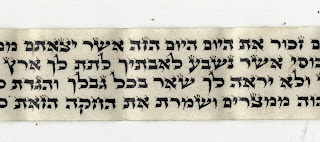Popular posts from this blog
Klaff Tanning question:
By
Rabbi Eli Gutnick
-
I received this question via email. I am not really a klaf expert, I was wondering if anyone could answer this question: Dear Rabbi Gutnick, I am writing to you because a good friend of mine has put the idea into my head that the klaf in my tefillin were not really tanned and therefore are not kosher. He referred me to Megilla 19a re diftera. From the research that I have done so far, it seems that the klaf that is used today is tanned only with a lime wash. On all of the tanning websites I’ve seen so far, they say that the lime doesn’t accomplish tanning but only the removal of the hair and some other pre-tanning effects. Would you be able to explain to me or refer me to a website that explains how the tanning process that is used today takes the hide out of the category of diftera? Thank you very much.
Rabbi Reuvain Mendlowitz clarifies his position on Ksav Chabad (and my final thoughts)
By
Rabbi Eli Gutnick
-
Last week I posted some thoughts in response to a public lecture given by Rabbi Reuvain Mendlowitz regarding Ksav Chabad (the Alter Rebbe's ksav). I felt he did not represent the issue fairly, and since I had received questions about it from a number of people I felt it made sense to write a general response. After I posted my response on this forum, Rabbi Mendlowitz reached out to me by email and we ended up having a respectful and productive email exchange regarding the relevant issues surrounding Ksav Chabad. His position is a lot clearer to me now, and I think he also took certain things on board that I clarified with him. The purpose of the Stam Forum (at least back in it's heyday before all the whats app groups took over) was to connect sofrim from around the world, to promote achdus and build bridges, as well as to offer support and advice. In that spirit, I felt I should write a follow up post, to clarify some of the issues and misconception...



the best I can suggest is erase the second hayom and stretch the mem stumah from the first hayom a little on the gug on the left side as well as to thicken the left side as well so that the gug is in proportion. Then add to the back of the gug of the hay as well as add to the regel so it is in proportion. In doing so you should ensure that the gap is 100%less than nine yudin. Assuming the thickening of the mem and hay is done proplerly, this should be the case.
ReplyDeleteThen, as an extra precaution, make holes in the gap.
The result, assuming you do the mem and hay correctly, will ensure the parshiyos are kosher, although with the gap, even with holes, It wont be geder mehudar.
You could erase the יום of the first היום and the ה of the second one and then stretch the gag of the first ה.
ReplyDelete? But how would the stretched hay be kosher? what would you do about the nekudah (left regel)? (If it was a daled I would understand the merit to such an argument)
DeleteSince there aren't many options we could be maikel b'shaas hadchak (keses 9-7)
Deleteyou mean do ponim chadashos with the left regel / nekudah? (ie keep adding ink and scratching as you extend the gug - it would be a delicate process).
DeleteIMHO I think that's more problematic than leaving a gap under 9 yudin. Ponim chadashos is lo kesidran according to the minority of opinions.
Typo - Ponim chadashos is possul according to the MAJORITY of opinions
DeleteI am not saying that he should move the regel b/c as you say that would be ponim chadoshos. What I am saying is to leave the regel and be moshech the gag, although the regel has to be under the end of the gag but b'shaas hadchak its kosher if a tinok reads it as a hey
ReplyDeleteI agree with Eli as this is the only correct tikkun. Whether a shiur parsha R"T with holes is lechatchila should be clarified with a posek of STAM.
ReplyDelete